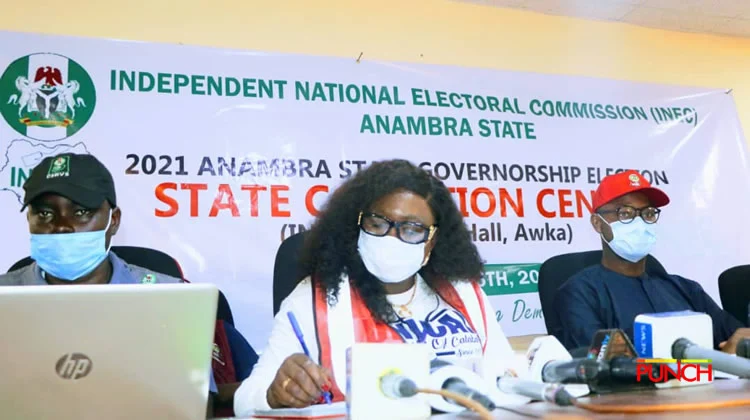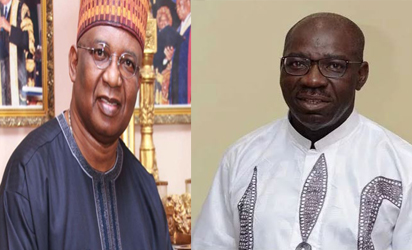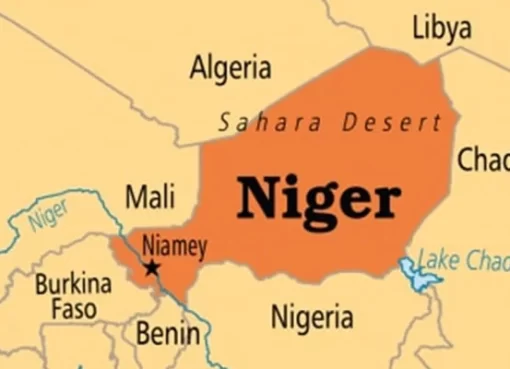Following Tuesday’s supplementary election in Ihiala Local Government Area, the much-awaited Anambra governorship election has been concluded with the candidate of the All Progressives Grand Alliance (APGA), Charles Soludo, declared the winner.
The election was important not just to Anambra State but to Nigeria, with the Independent National Electoral Commission (INEC) calling it a “great test” to Nigeria’s democracy.
The final results announced early Wednesday by INEC showed that Mr Soludo polled 112,229 votes to see off the challenge from his closest rival, Valentine Ozigbo of the Peoples Democratic Party (PDP), who polled 53,807 votes.
Andy Uba of the All Progressives Congress (APC) came third with 43,285 votes while Ifeanyi Ubah, the candidate of the Young Progressive Party (YPP), came behind with 21,261 votes.
As predicted by PREMIUM TIMES, the four candidates mentioned above were the leading contenders but Mr Soludo won with a wide margin, clearing 19 of the 21 local governments in the state.
Both Mr Ozigbo of PDP and Mr Ubah of YPP won one local government each in the race.
Of the 2,466,638 registered voters in Anambra as announced by INEC, only 253,388 were accredited. In the end, there were only 253,388 votes cast, of which 8,108, were rejected.
This means only 10 per cent of the registered voters in the state voted during the election. Simply put, only one in every ten registered voters in the state’s 21 local government areas, consisting of 326 wards and 5,720 polling units, voted on Saturday and Tuesday.
Election observers and civil society organisations had predicted the low voters’ turnout which they said could be due to “late arrival of election materials, lack of trust and fear of violence.” A PREMIUM TIMES analysis showed a trend that is deeply rooted in the state.
A survey by SBM Intelligence, a geopolitical research firm, earlier predicted that 60 per cent of registered voters had decided not to participate in the election. Reasons given by some of the respondents include insecurity and lack of trust in the electoral system. Also, many people that came out to vote could not do so because of the failure of INEC’s BVAS machine which was meant to accredit registered voters before they are allowed to vote.
This newspaper also reported how the election campaign season was characterised by fear of attack by the separatist group, IPOB.
The polity was tense, prompting federal authorities to deploy a large number of police officers. The deployment of over 34,000 police officers and thousands of other security personnel was to stop any violent acts by IPOB and other armed groups during the election, especially as IPOB had declared a sit-at-home order to coincide with the election. IPOB only announced the cancellation of the sit-at-home order two days before the election.
Despite the cancellation, analysts said the “fear was palpable” because the group’s sit-at-home order has been so successful that even when it lifts the ban, “residents still sit-at-home either out of solidarity or to err on the side of caution.”
History of voter turnout in Anambra
Since the consolidation of democracy in 1999, elections in Anambra State have been marred by low voter turnout.
The governorship elections in the state have never witnessed up to 50 per cent voter turnout with the highest being 2007 when the election was characterised by allegations of massive rigging, according to the Centre for Democracy and Development (CDD).
However, although the voter turnout in previous governorship elections in Anambra was low, the recent election had the lowest turnout.
Of the 2.2 million registered voters in 1999, only 1.02 million voted in the 1999 election, representing 46.4 per cent. The 2003 election saw the highest turnout with 47.22 per cent.
Of the 1.84 million registered voters in the state in 2010, only 302,000 voted on election day. This translates to about 16 per cent of voters.
In 2013, only 465,891 of the total 1,770,127 registered voters actually voted on election day – representing about 25 per cent.
Likewise, in the 2017 election, less than a quarter of the total number of registered voters actually participated in the polls. INEC said of the 2,064,134 residents registered as eligible voters for the election, only 448,711 – about 21 per cent – showed up to vote.
The turnout reached a nadir in Saturday’s election which had a turnout of 10 per cent.
Voter apathy, a pattern in Nigeria’s fourth republic
Aside from Anambra, Nigerians’ aversion to voting during elections is well pronounced. This is despite the huge amount of money spent by the government.
In the last two electoral cycles, including off-season elections, voter turnout across the country has been lower than 35 per cent, according to INEC official figures.
Only a few elections had higher percentages. Some recent by-elections recorded as low as 3 and 8 per cent voter turnout.
Last September, only a quarter of the eligible voters voted in the Edo governorship election, a historic low and a decline from 32 per cent in 2016.
In the Ondo governorship election too, of the 1,812,634 eligible voters, only 32.8 per cent (or 595,213) turned out. In 2016, the turnout was 35.6 per cent.
Other reasons for low turnout
Some observers have said that abstinence from elections could be the people’s way of showing civic rebellion due to failed promises by elected officials.
More than this, elections in the country are sometimes marred by violence and disruptions. From 2006 to 2015, about 4,000 lives were lost during elections, Crisis group said in its 2018 report.
Similarly, the history of questionable elections conducted by INEC, like the 2007 polls, which international overseers described as a “charade” adds to the reasons voters boycott elections.
In addition, the lack of trust of eligible voters in the electoral system as well as the government has also proven to be a contributing factor to the low voter turnout in Nigerian elections.
PREMIUM TIMES






